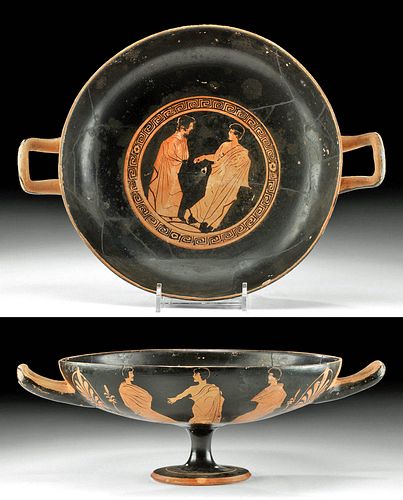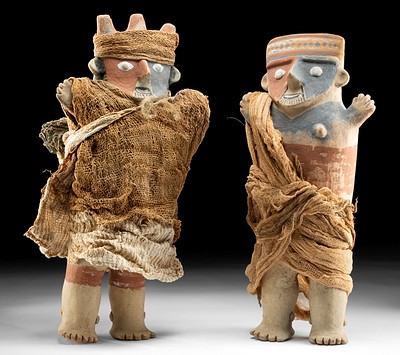Greek Attic Red-Figure Stemmed Kylix w/ Ephebes
Lot 10
About Seller
Artemis Fine Arts
686 S Taylor Ave, Ste 106
Louisville, CO 80027
United States
Selling antiquities, ancient and ethnographic art online since 1993, Artemis Gallery specializes in Classical Antiquities (Egyptian, Greek, Roman, Near Eastern), Asian, Pre-Columbian, African / Tribal / Oceanographic art. Our extensive inventory includes pottery, stone, metal, wood, glass and textil...Read more
Categories
Estimate:
$3,000 - $4,000
Absentee vs Live bid
Two ways to bid:
- Leave a max absentee bid and the platform will bid on your behalf up to your maximum bid during the live auction.
- Bid live during the auction and your bids will be submitted real-time to the auctioneer.
Bid Increments
| Price | Bid Increment |
|---|---|
| $0 | $25 |
| $300 | $50 |
| $1,000 | $100 |
| $2,000 | $250 |
| $5,000 | $500 |
| $10,000 | $1,000 |
| $20,000 | $2,500 |
| $50,000 | $5,000 |
| $100,000 | $10,000 |
| $200,000 | $20,000 |
About Auction
By Artemis Fine Arts
May 19, 2022
Set Reminder
2022-05-19 10:00:00
2022-05-19 10:00:00
America/New_York
Bidsquare
Bidsquare : Fine Antiquities | Ethnographica | Fine Art
https://www.bidsquare.com/auctions/artemis-gallery/fine-antiquities-ethnographica-fine-art-9350
Featuring a very special collection of Fine Art from the Hollywood Hills, including Picasso & Rookwood ceramics! Also included are many fine examples of classical antiquities, ancient, and ethnographic art from cultures encompassing the globe. Artemis Fine Arts info@artemisfinearts.com
Featuring a very special collection of Fine Art from the Hollywood Hills, including Picasso & Rookwood ceramics! Also included are many fine examples of classical antiquities, ancient, and ethnographic art from cultures encompassing the globe. Artemis Fine Arts info@artemisfinearts.com
- Lot Description
Ancient Greece, Athens, ca. 500 to 480 BCE. A beautiful pottery kylix, expertly hand-painted with images of ephebes or Greek youths in red-figure technique. Boasting a classically elegant profile, the dish sits upon a pedestal foot, displaying impressively thin walls that flare out to a broad, annular rim flanked by twin, upwards arching handles. A central tondo adorns the basin, featuring a pair of conversing youths swathed in peploi and crowned by thick coiffures. The ephebe on the left is shown in profile facing right and draped in a hemmed himation, while his companion stands with legs crossed, presenting a bare shoulder and arm which he extends outward. A lovely border of meander and cross motifs encircles the scene. The exterior of the vessel showcases similar scenes, presenting a trio of ephebes in avid discourse on each side. All of the figures also wear peploi, as each scene shows 2 of the ephebes confronting - 1 of which extends an arm towards the other - as the third youth observes the discussion. Size: 11.6" Diameter x 4" H (29.5 cm x 10.2 cm)
Three palmette designs embellish the area beneath each handle, while the majority of the kylix is enveloped in a lustrous black glaze, save for the top of the rim and handles, as well as the edge of the foot and a slender circle that surrounds the base of the leg.
Virtually no ancient Greek paintings have survived the tests of time. This makes the painted compositions found on ceramic vessels like this example invaluable sources of information about ancient Greek visual art. Refined dishes like this kylix were not merely utilitarian pottery, but rather works of art in their own right, highly prized throughout the classical world.
Perhaps the most exciting innovation in Greek vessel painting was the red-figure technique, invented in Athens around 525 BCE and beloved by other artists of Magna Graecia. The red-figure technique allowed for much greater flexibility as opposed to the black-figure technique, for now the artist could use a soft, pliable brush rather than a rigid metal graver to delineate interior details, play with the thickness of the lines, as well as build up or dilute glazes to create chromatic effects. The painter would create figures by outlining them in the natural red of the vase, and then enrich these figural forms with black lines to suggest volume, at times perspectival depth, and movement, bringing those silhouettes and their environs to life.
According to the Walter's Museum of Art, "Kylikes were the most common form of drinking vessel in ancient Greece. The exterior was often elaborately decorated, while the tondo in the center was revealed after the contents of the cup were consumed (the scenes were sometimes amusing as well as artistic) ...At the end of a symposium, the reveler might have used this kylix to participate in a game of kottabos, which involved flinging the dregs of his wine from his cup at a target."
A nearly identical kylix decorated with red-figure youths was published in Sotheby's London's sale catalogue for 11 December 1989 as lot 130 on pages 74 and 78.
Provenance: private Wabasha, Minnesota, USA collection; ex-Nancy and Dr. E.F. Simpson collection, Los Angeles, California, USA, acquired from 1970 to 2000
All items legal to buy/sell under U.S. Statute covering cultural patrimony Code 2600, CHAPTER 14, and are guaranteed to be as described or your money back.
A Certificate of Authenticity will accompany all winning bids.
PLEASE NOTE: Due to recent increases of shipments being seized by Australian & German customs (even for items with pre-UNESCO provenance), we will no longer ship most antiquities and ancient Chinese art to Australia & Germany. For categories of items that are acceptable to ship to Australia or Germany, please contact us directly or work with your local customs brokerage firm.
Display stands not described as included/custom in the item description are for photography purposes only and will not be included with the item upon shipping.
#171822Professionally repaired and restored with repainting over break lines. Break lines visible in some areas. A few areas of over-painting. Perforation at center of basin. Expected surface wear with minor chipping to rim and foot, as well as some small nicks and abrasions, all commensurate with age. Otherwise, excellent with great remaining pigment and detail.Condition
- Shipping Info
-
All shipping is handled in-house for your convenience. Your invoice from Artemis Gallery will include shipping calculation instructions. If in doubt, please inquire BEFORE bidding for estimated shipping costs for individual items.
-
- Buyer's Premium



 EUR
EUR CAD
CAD AUD
AUD GBP
GBP MXN
MXN HKD
HKD CNY
CNY MYR
MYR SEK
SEK SGD
SGD CHF
CHF THB
THB
















